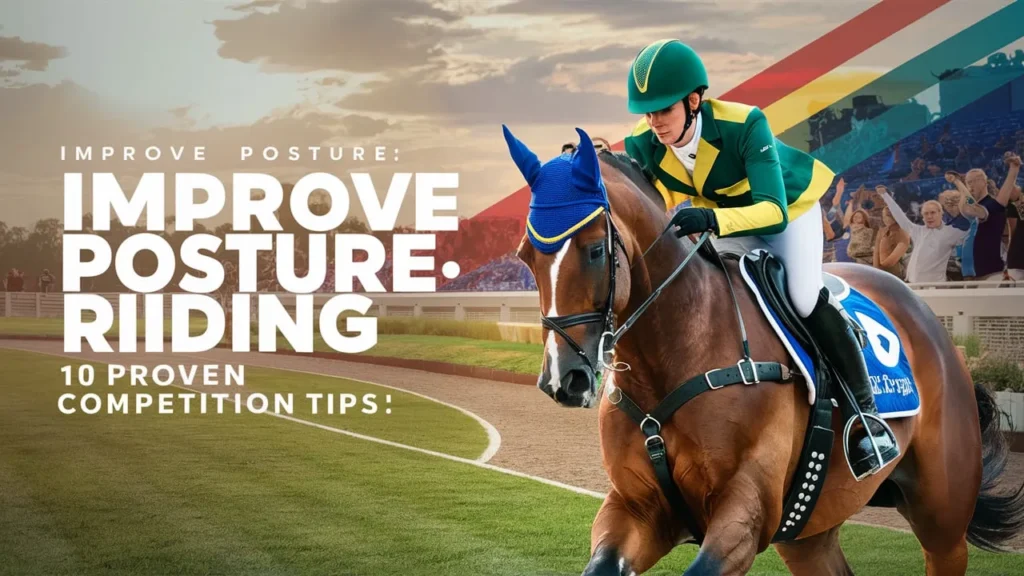Improve Posture Horseback Riding
Good posture in horseback riding is essential for comfort, control, and success in competitive events. Whether you’re new to the equestrian world or looking to sharpen your skills, improving your posture can enhance your riding experience and boost your performance in competitions. In this guide, we’ll dive into practical tips to help you improve posture in horseback riding and get competition-ready.
Introduction
Horseback riding isn’t just about holding the reins and controlling the horse; it’s about creating harmony between your body and the animal. A proper posture not only improves your riding skills but also ensures the horse’s comfort and safety. From Equestrian competition posture advice to casual riding, having correct posture can be the difference between an okay ride and an extraordinary performance.
In this article, we’ll cover 10 proven horseback riding posture tips to help you gain confidence and excel in competitions, from dressage to show jumping.
Read More: Best Cricket Fielding Positions Explained for 2024

Why Is Good Posture Important in Horseback Riding?
Before diving into the tips, it’s essential to understand why posture plays such a critical role. A correct posture allows you to communicate more effectively with your horse. The more balanced and centered you are in the saddle, the better control you have over your horse’s movements.
When your posture is off, it creates discomfort for both you and the horse. Over time, poor posture can lead to physical strain, reduced performance, and even injury.
Tip 1: Align Your Spine
One of the most important tips for improving Posture in show jumping horseback riding is to maintain a straight spine. Imagine a string pulling the top of your head upward, aligning your spine from your tailbone to your neck. Maintaining balance and awareness of your horse’s movements is much easier with this alignment.
Key point: Avoid slouching or over-arching your back, as this disrupts the flow between you and the horse.
Tip 2: Engage Your Core
Your core muscles play a significant role in maintaining a stable posture. Engaging your core gives you better balance and control while riding. This doesn’t mean tensing your stomach, but rather keeping your core muscles active to support your back.
Your stability and endurance may be enhanced by including core strength exercises like leg lifts and planks into your equestrian riding regimen.
Tip 3: Relax Your Shoulders
It’s easy to tense up when focusing on riding, but stiff shoulders can throw off your balance and make your movements jerky. Instead, keep your shoulders relaxed and rolled back. This posture opens up your chest and allows for smoother, more fluid communication with the reins.
Key point: Relaxing your shoulders helps distribute your weight evenly and keeps you from leaning too far forward or back.
Tip 4: Look Ahead
Where your eyes go, your body will follow. In competitive riding, it’s crucial to keep your gaze forward and look ahead in the direction you want to go. Looking down can cause you to hunch over, which negatively affects your balance.
Key point: Keeping your eyes up helps you anticipate your horse’s next movements and ensures a smoother ride.
Tip 5: Balance Your Weight Evenly
Good posture in horseback riding requires equal weight distribution across both seat bones. If you lean to one side, it can unbalance your horse and cause uneven movements.
Tip for show jumping: Correcting posture for show jumping is crucial. Maintaining even weight distribution ensures smoother landings and tighter turns during the jump.
Tip 6: Strengthen Your Legs
Your legs provide stability and control while riding. Strong leg muscles help you stay connected to your horse, especially when navigating through fast turns or tight movements in competitions.
Adding exercises like lunges and squats to your training regimen can strengthen your legs and correct your posture when riding a horse.
Tip 7: Use Proper Saddle Fit
The saddle plays a significant role in maintaining a good posture. Horseback riding core exercises a poorly fitted saddle can throw off your balance and posture, leading to discomfort for both you and the horse.
Make sure the saddle is properly adjusted to support your body and promote correct alignment. A well-fitting saddle helps maintain proper posture for long periods, especially in competitive riding.
Tip 8: Focus on Breathing
It might sound simple, but many riders forget to breathe properly when concentrating. Controlled breathing helps you relax and maintain a balanced posture. When you hold your breath, your body tends to stiffen, which can affect your posture.
Dressage tip: For Dressage posture correction improvement tips, focus on deep, even breaths to stay relaxed and centered, which improves fluidity during intricate movements.

Tip 9: Incorporate Stretching Exercises
Having flexibility is essential for keeping good posture. Horse riding balance and posture Tight muscles can restrict your movement and make it harder to stay balanced in the saddle. Regular stretching helps improve your flexibility and posture.
Incorporate yoga or dynamic stretches before and after riding to loosen up your muscles and reduce stiffness. Best posture for equestrian events these exercises will aid in preventing injuries and keeping your body agile.
Tip 10: Practice Regularly
Improving posture in horseback riding takes time and consistent practice. The more you ride, the better you’ll become at maintaining a good posture.
Key point: Consistent practice helps build muscle memory, making it easier to maintain correct posture naturally without overthinking.
People Also Ask
What is horseback riding called?
Horseback riding is also called equestrianism.
What is the meaning of horseback riding?
Horseback riding means the act of riding a horse.
What is horseback riding for?
Horseback riding is for transportation, sport, recreation, or competition.
What is the horse riding thing called?
Conclusion
Correcting your posture in horseback riding is a vital part of becoming a better, more competitive rider. By following these 10 proven tips, you can improve your posture, communicate more effectively with your horse, and enhance your performance in equestrian competitions. Remember, good posture isn’t just about sitting straight—it’s about creating a balance between strength, flexibility, and control.
FAQs
1. How can I improve my posture for show jumping?
To improve your posture for show jumping, focus on maintaining even weight distribution, engaging your core, and keeping your gaze forward. Practice with small jumps to build confidence and control.
2. What exercises can help improve my horseback riding posture?
Core strength workouts like planks, leg lifts, and lunges can strengthen your muscles and improve your posture. Stretching exercises, such as yoga, can also enhance flexibility.
3. How does breathing affect my riding posture?
Proper breathing helps you stay relaxed and balanced. Shallow or irregular breathing can cause tension, which negatively impacts your posture.
4. Why is saddle fit important for posture?
A properly fitted saddle supports your alignment and balance, ensuring you maintain good posture while riding. A poor fit can cause discomfort and throw off your positioning.
5. How long does it take to improve posture in horseback riding?
Improving posture varies from rider to rider, but with consistent practice and exercises, you can see noticeable improvements within a few weeks to a few months. Regular lessons and feedback can also speed up the process.




